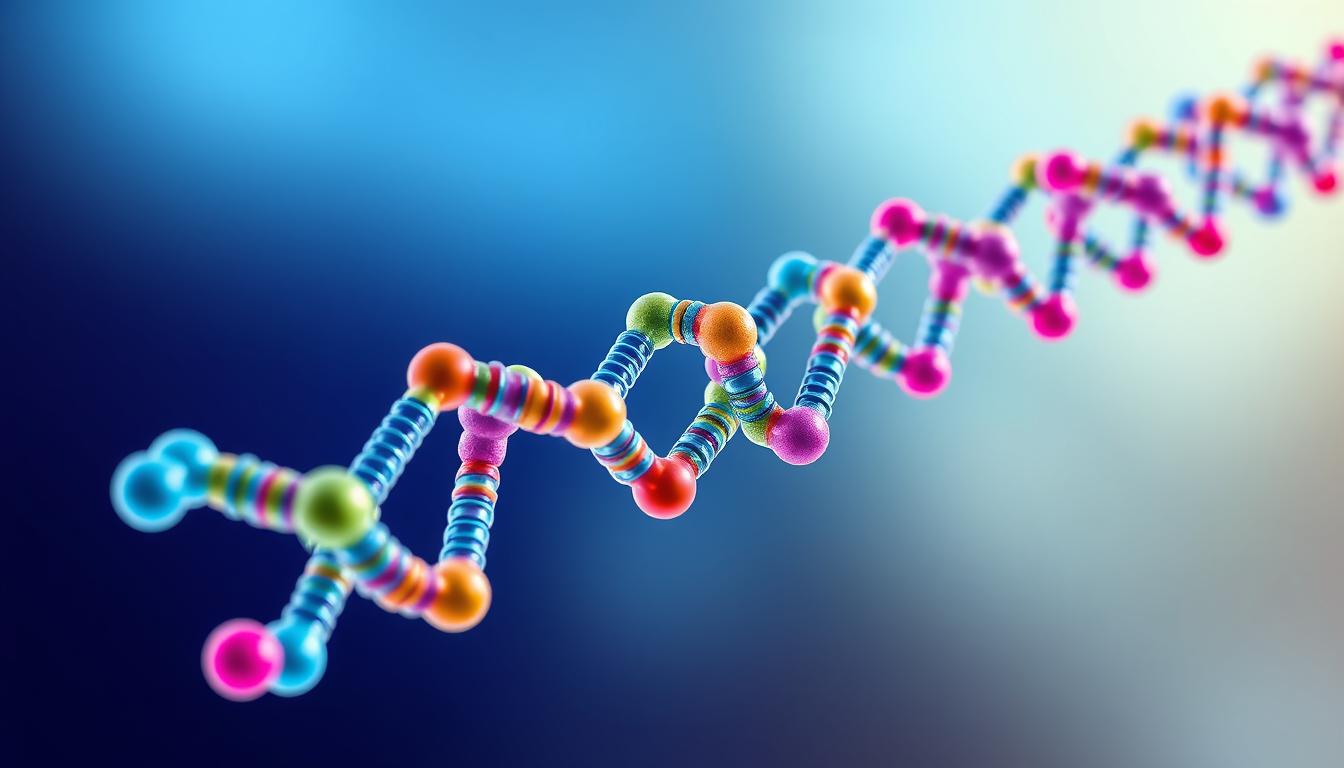How Peptides Work: A Comprehensive Guide

Peptides are key parts of proteins and play a big role in our bodies. They are short chains of amino acids, usually 2 to 100 in length. They help with things like insulin control, skin health, and muscle growth1.
Insulin, a 51-amino acid peptide hormone, has been used to treat type 1 diabetes since 1923. This was a big step in using peptides for medical treatments1. Today, over 100 peptide drugs have been approved by the FDA. They help with conditions like prostate cancer, HIV, type 2 diabetes, and chronic pain1.
Key Takeaways
- Peptides are short chains of amino acids that serve as building blocks for proteins and play crucial roles in the body.
- Insulin, a peptide hormone, has been used to treat type 1 diabetes since 1923, marking a significant milestone in peptide-based medical treatments.
- Peptides offer advantages over traditional drugs, such as targeted delivery, fewer side effects, and safe byproducts upon breakdown.
- Peptides have been incorporated into various industries, including skincare and dietary supplements, for their anti-aging, muscle-building, and other beneficial effects.
- The human body produces over 7,000 known types of peptides, indicating the vast potential for peptide-based therapies in various health and wellness sectors2.
Understanding the Fundamentals of Peptides
Peptides are the building blocks of proteins and play a key role in many biological processes. They are made of amino acids linked by peptide bonds. This creates a backbone with side chains sticking out3. Peptides can be short or long, with oligopeptides having less than 20 amino acids and polypeptides more3.
Basic Structure and Formation
Types of Peptide Bonds
Difference Between Peptides and Proteins
“Peptides are the building blocks of life, playing crucial roles in numerous biological processes and holding immense potential for therapeutic applications.”
The Science Behind How Peptides Work
Peptides are key to our body’s complex processes. They act as signaling molecules, enzymes, and hormones. These small chains of amino acids interact with cell receptors, starting a chain of responses5. For example, insulin helps cells take in glucose, while antimicrobial peptides damage bacteria5.
| Bioactive Peptide Functions | Examples |
|---|---|
| Antimicrobial | Peptides from eggshells, chicken blood, cow/goat milk, beef, and whey |
| Appetite and Digestion Regulation | Peptides from food sources like soybeans, sweet potatoes, fish, and seafood |
| Cardiovascular Health | Cholesterol-lowering and blood pressure-regulating peptides |
| Skin Health | Peptides for photoprotection, photoaging, and wound healing |
Natural vs. Synthetic Peptides: Key Differences
The world of peptides is vast, with both natural and synthetic types. Knowing the differences between them is key to using peptides effectively. This is true for skincare and medical treatments8.
Endogenous Peptides
Endogenous peptides are made in our bodies. They help with hormone regulation and cell communication. Naturally occurring peptides come from proteins and can be short or long9.
Laboratory-Created Peptides
Bioavailability and Absorption
| Characteristic | Endogenous Peptides | Synthetic Peptides |
|---|---|---|
| Origin | Naturally produced within the body | Laboratory-created through specialized synthesis techniques |
| Size | Ranging from a few amino acids to several hundred | Typically 20-50 amino acids in length |
| Bioavailability | Varies depending on method of administration | Can be modified to improve stability and absorption |
| Applications | Regulate biological processes, facilitate cellular communication | Mimic natural peptides, introduce unique properties |
“Peptides, whether natural or synthetic, have become increasingly valuable in various fields, from skincare to therapeutic applications. Understanding the unique characteristics of each type is crucial in unlocking their full potential.”
Essential Functions of Peptides in the Body

Therapeutic Applications and Medical Benefits
Peptides are becoming key players in medicine, helping treat many health issues13. Over 80 peptide drugs are now approved for use, including 30 for non-insulin conditions like oxytocin and vasopressin13. From 2016 to 2022, the FDA approved 26 peptides as new drugs, showing a big leap in drug development13.
Treatment of Various Conditions
Peptide drugs are making a big impact in treating diseases like diabetes, cancer, and heart issues13. They are known for being specific and safe, unlike some traditional drugs. For example, drugs like Abarelix for cancer, Exenatide for diabetes, and Teriparatide for bone health have shown great results13.
Drug Development and Delivery
Clinical Research Findings
Peptides offer more than just traditional drug benefits14. Their size and flexibility help them target specific interactions, but they also face challenges like poor membrane penetration and short lifespans14. Still, research shows peptides can greatly help in treating diseases where other drugs fall short1314.
“Peptide-based drugs have the potential to revolutionize the way we treat a wide range of medical conditions, offering targeted and efficient solutions that complement traditional small-molecule therapies.”
| Metric | Value |
|---|---|
| Approved Peptide Drugs | 80+, including 30 non-insulin peptides |
| Peptide Drugs Approved (2016-2022) | 26 out of 315 new drugs |
| Peptides in Clinical Development | Over 200 |
| Peptides in Preclinical Studies | 600+ |
| Peptide Drugs Market Size (2022) | $42.05 billion (5% of global pharma market) |
| Peptide Drugs Market CAGR (2023-2032) | 10% |
Peptides in Skincare and Anti-Aging
Peptides have changed the game in skincare and anti-aging. These small protein pieces can greatly improve skin health and tackle age-related issues. Collagen peptides boost skin elasticity and reduce wrinkles when used as supplements or applied to the skin. Copper peptides, like GHK-Cu, boost collagen and act as antioxidants, protecting the skin from harm.
Palmitoyl pentapeptide-4, or Matrixyl, is a synthetic peptide used in skincare. It stimulates collagen production and improves skin texture15. Some products also use antimicrobial peptides to keep the skin healthy and fight acne-causing bacteria.
Peptides are often mixed with vitamin C and hyaluronic acid to fight wrinkles15. This mix uses each ingredient’s unique benefits for better anti-aging results.
“Peptides have become a game-changer in the world of skincare and anti-aging.”

Role of Peptides in Muscle Growth and Recovery
Peptides are key in muscle growth, athletic performance, and recovery. They are popular in fitness and sports for boosting muscle development and repair. These compounds are versatile and essential for athletes and fitness enthusiasts.
Muscle Building Mechanisms
Peptides help muscles repair faster by boosting protein synthesis and lowering inflammation. This makes recovery from workouts quicker17. Creatine and collagen peptides stimulate muscle growth and repair damaged tissue17. Growth hormone-releasing peptides (GHRPs) also boost growth hormone, helping muscles grow and recover17.
Athletic Performance Enhancement
Recovery and Repair
“Peptides have been effective in enhancing recovery, reducing muscle soreness, and improving performance for athletes and post-surgery patients.”17
| Peptide | Function | Benefits |
|---|---|---|
| BPC-157 | Accelerates healing of wounds, muscles, and tendons | Improved recovery from injuries and physical exertion |
| TB-500 (Thymosin Beta-4) | Promotes wound healing, tissue repair, and reduces inflammation | Enhanced recovery and reduced inflammation |
| CJC-1295 and Ipamorelin | Stimulate the body’s production of growth hormone | Muscle growth, fat loss, and improved recovery |
Safety Considerations and Potential Side Effects
Many peptides are safe when used correctly, but there are risks19. FDA-approved peptide drugs are tested well, but supplements might not be checked as closely19. Side effects can include reactions at the injection site, allergies, and hormonal issues19. The long-term effects of some peptides are still unknown19.

“Peptide therapies offer promising benefits, but their safety and efficacy must be thoroughly evaluated through rigorous clinical trials and regulatory oversight.”
Future Trends in Peptide Research
The field of peptide research is growing fast, thanks to new technologies and creative methods20. Right now, over 40 peptide-based drugs are in the final stages of testing21. More than 400 peptide drugs are being tested worldwide, with over 60 already approved for use in places like the U.S., Europe, and Japan.
Emerging Technologies
Potential Breakthroughs
Future discoveries might include personalized peptide treatments and better ways to deliver them20. Companies like Bachem are growing to meet the demand for these medicines.
Industry Developments
Conclusion
Peptides are a powerful group of molecules that have changed many fields, like medicine and skincare. They work like our bodies do, making them key in treating many health issues and improving our overall health23.
But, we must always think about safety and how well peptides work. We need to watch for any bad reactions and know their limits. Yet, the future of peptides looks very promising, with new discoveries and improvements on the way24.
FAQ
What are peptides and how do they work?
Peptides are short chains of amino acids. They are key to many body functions, like controlling blood sugar. They can be found naturally or made in labs, used for health and beauty.
What is the difference between peptides and proteins?
Peptides are shorter, with 2-100 amino acids. Proteins are longer, with more chains of amino acids.
How are peptides formed and classified?
Peptides form when amino acids link together, losing a water molecule. They are divided into oligopeptides (short) and polypeptides (longer).
What are the functions of peptides in the body?
Peptides act as signals, enzymes, and hormones. They interact with cells to start various body responses, like controlling metabolism and immune responses.
What are the differences between endogenous and synthetic peptides?
Endogenous peptides are made by the body. Synthetic peptides are made in labs. Their absorption and use depend on their structure and how they are given.
What are the therapeutic applications of peptides?
Peptides are used to treat many diseases, like diabetes and cancer. They are specific and safe, unlike some drugs.
How are peptides used in skincare and anti-aging products?
In skincare, peptides help with elasticity and wrinkles. Products like collagen peptides and copper peptides boost collagen and act as antioxidants.
What is the role of peptides in muscle growth and recovery?
Peptides are key for muscle growth and recovery. Creatine and collagen peptides help repair muscles. Some peptides, like BPC-157, aid in wound healing.
What are the safety considerations and potential side effects of peptides?
Many peptides are safe when used right. But, there are risks like allergic reactions and hormonal imbalances. FDA-approved drugs are tested well, but supplements may not be as safe.
What are the future trends in peptide research?
Peptide research is growing fast, with new tech like machine learning. We might see personalized treatments and better delivery methods soon.
Source Links
- https://www.webmd.com/a-to-z-guides/what-are-peptides – What Are Peptides?
- https://livvnatural.com/types-of-peptides-and-their-uses/?srsltid=AfmBOoppHNUbrl637At0Mmwdq3PriiA1XMxFNhXHgWTSMba5LRNZC6iM – Types of Peptides & Their Uses: A Full Guide | Livv Natural
- https://www.ncbi.nlm.nih.gov/books/NBK562260/ – Biochemistry, Peptide – StatPearls – NCBI Bookshelf
- https://chem.libretexts.org/Bookshelves/Organic_Chemistry/Basic_Principles_of_Organic_Chemistry_(Roberts_and_Caserio)/25:_Amino_Acids_Peptides_and_Proteins/25.07:_Peptides_and_Proteins – 25.7: Peptides and Proteins
- https://www.aocs.org/stay-informed/inform-magazine/featured-articles/the-power-of-peptides-november/december-2015?SSO=True – The power of peptides
- https://lpi.oregonstate.edu/mic/health-disease/skin-health/peptides – Peptides and Skin Health
- https://bostonvitality.com/the-science-behind-peptides/ – The Science Behind Peptides – Boston Vitality
- https://bitesizebio.com/49171/synthetic-peptides/ – Synthetic Peptides: Better Than Recombinant Proteins?
- https://www.bareluxeskincare.com/blogs/elevated-simplicity/peptides-in-skincare?srsltid=AfmBOorGJBxWrr5kWNl3lz8gt7RhGOEAMNauh0NJxHUwlv0knY8YYfCH – Understanding the Power of Peptides in Skincare
- https://pmc.ncbi.nlm.nih.gov/articles/PMC10816548/ – Synthetic Peptides and Peptidomimetics: From Basic Science to Biomedical Applications—Second Edition
- https://www.verywellhealth.com/what-is-a-peptide-5084580 – What Are Peptides?
- https://www.medicalnewstoday.com/articles/326701 – Peptides: What are they, uses, and side effects
- https://pmc.ncbi.nlm.nih.gov/articles/PMC10609221/ – Peptides as Therapeutic Agents: Challenges and Opportunities in the Green Transition Era
- https://www.nature.com/articles/s41392-022-00904-4 – Therapeutic peptides: current applications and future directions – Signal Transduction and Targeted Therapy
- https://www.health.com/beauty/skincare/what-are-peptides – What Are Peptides? How This Anti-Aging Ingredient Affects Your Skin
- https://pmc.ncbi.nlm.nih.gov/articles/PMC6981886/ – Anti-Wrinkle Benefits of Peptides Complex Stimulating Skin Basement Membrane Proteins Expression
- https://www.performancepain.com/blog/the-role-of-peptides-in-accelerating-recovery-and-muscle-growth – The Role of Peptides in Accelerating Recovery and Muscle Growth: Performance Pain and Sports Medicine: Interventional Pain Management Specialists
- https://www.performancepain.com/blog/peptides-for-muscle-growth-do-they-work – Peptides for Muscle Growth: Do They Work?: Performance Pain and Sports Medicine: Interventional Pain Management Specialists
- https://gentlegiantcarellc.com/any-known-side-effects-of-peptide-therapy/ – Peptide Therapy Unveiled: Exploring Potential Side Effects
- https://www.bachem.com/articles/peptides/the-latest-trends-in-peptides-and-oligonucleotides/ – The Latest Trends in Peptides and Oligonucleotides
- https://www.news-medical.net/health/The-Potential-of-Peptide-Therapeutics-in-Treating-Chronic-Diseases.aspx – The Potential of Peptide Therapeutics in Treating Chronic Diseases
- https://academic.oup.com/bib/article/25/4/bbae275/7690345 – Peptide-based drug discovery through artificial intelligence: towards an autonomous design of therapeutic peptides
- https://pmc.ncbi.nlm.nih.gov/articles/PMC8844085/ – Therapeutic peptides: current applications and future directions
- https://www.drpaulnassif.com/blog/maximizing-facelift-results-with-peptides/ – Maximizing Facelift Results with Peptides | Dr. Paul Nassif












